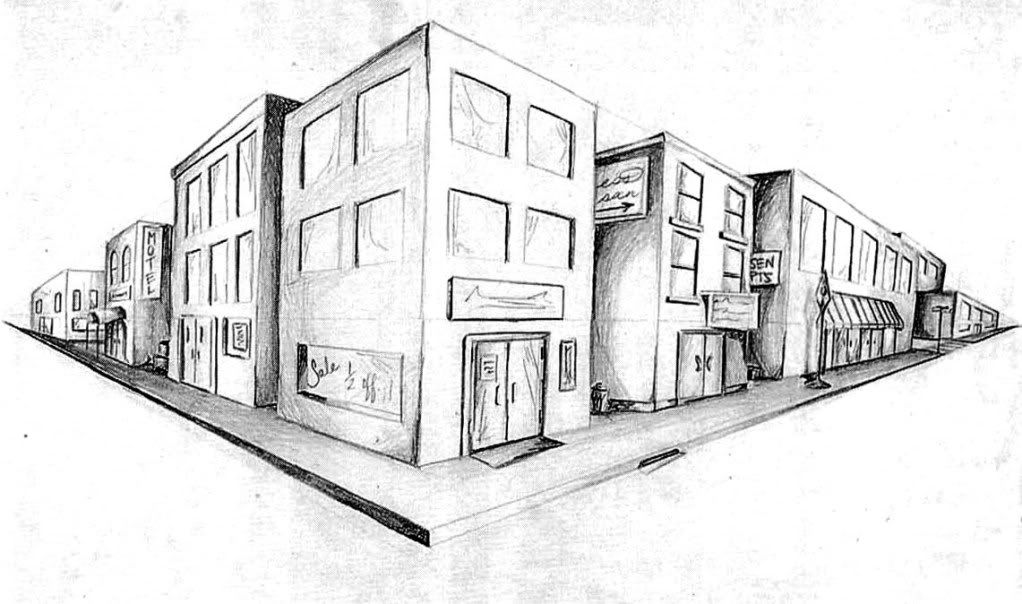Author's Note
Truthfully, when I read the assignment details for writing project 2, I was less than excited. It just seemed like an overgrown version of the first writing project, but instead of using one photograph, we would be using three or four hand-drawn pictures. Little did I realize that I could skew this assignment back toward a way that benefited me both intellectually and personal interests. I knew right away that I did not want to use a comic I was unfamiliar with. I wanted it to be something I at least had some background information on. So as I looked, I stumbled on this Calvin and Hobbs cartoon. Though I did not by any means grow up on Calvin and Hobbs, I certainly knew a bit about the idea. A boy and his tiger and they go on adventures, how much harder could it be?
As with the first writing assignment, my dislike for editing hit again. I did change significantly more in this assignment than the first however. For instance, from the first draft to the second, I included nearly an entire introduction. The first version had just a sentence lead into the comic, but no introduction. In the second draft, I included a cohesive introduction that flows into the body much like the first, but with more background and introduction than the first draft allowed for. Also, I added a few terms from "Compose, Design and Advocate" that were necessary to tie the piece together.
This project tought me how to work with things that I don't like at first in order to put a spin on them that will create a better suited idea for me. When I am able to turn a project in my favor, it better enables me to write a paper that is acceptable and create a writing environment better suited to my skills. When in a predicament that leads to unsuccessful writing products, I am shown that I did not put in enough effort to taylor the assignment to fit my needs. I also need to learn that my writing isn't perfect and not to be so picky over edits. I'm sure that will also come in time.
Links
Rough Draft 2Rough Draft 1Statement of PurposeWriting Project 2
The medium of comic writing is a well underrated method of getting a substantial idea across to a mass audience while also keeping them entertained. A coming writer can have an entirely different message than what comes out the first time a paneled strip is read. A simple trick or treat encounter can turn into a massive plea to the American public to wake up and understand that something is wrong with how we do things. In a day where few children dress up as a classic vampire, Frankenstein or other normally scary figure in exchange for their favorite character from a television show,
Bill Watterson, creator of "
Calvin and Hobbs" takes it one step further:
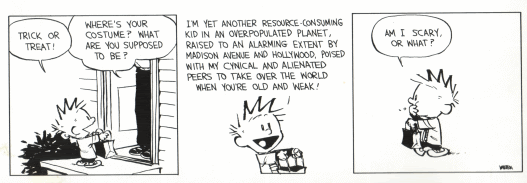
In this cartoon, Watterson uses Calvin's innocence as a young child as his scary costume. By juxtaposing the innocent young boy against the contextual reality of his actual standing in the world, it is obvious to see Calvin's costume is much scarier than what the reader would originally think, which is also why this cartoon is able to make a point. If instead of the cynical cartoon, the reader instead simply saw a model of
population trend like the one below, the point would not be the same.
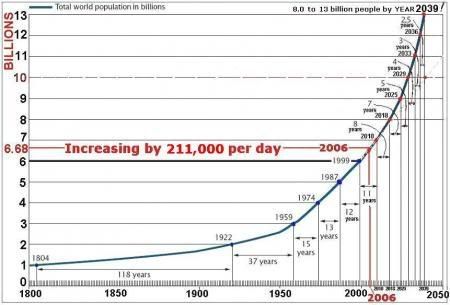
Sure this graph proves the same point of where global population is heading and that any one child is "just another resource-consuming kid in an overpopulated planet." At the same time, the graph fails to have the medium of voice that a cartoon has that can "speak" to the reader and help them und

erstand through means of persuasion rather than simply presented facts. This is the same reason that activist's like
Al Gore chose the medium of film production to get points across instead of only writing a book or publishing graphs and statistics in a newspaper. By being able to voice an opinion, either through creative writing or voice itself, a person has a much better chance of getting general people to understand the idea they are setting forth.
All this brings us back to Bill Watterson and why he would create this cartoon in the first place, of which there are many reasons. First off, Watterson was born in Washington D.C., but moved to
Chagrin Falls, Ohio at an early age where his mother became a town council representative leaving Watterson with a childhood full of political upbringing. Watterson then moved on to college where he defied his parents wishes for him to go into writing, and instead graduated with a degree in political science. So although this comic could have easily been created by anyone adapt to watching the news and realizing overpopulation is an issue, a person like Watterson with deep political influence is only creating on the topic he knows best.
Calvin and Hobbs was written over a 10 year period mostly during the 1980s. Watterson's cartoons often conveyed a deep meaning but at the same time were generally funny for children to read as well, although they most likely did not understand the true points of the writing. When Calvin and Hobbs first came out an eight or nine year old would see a tiger and a
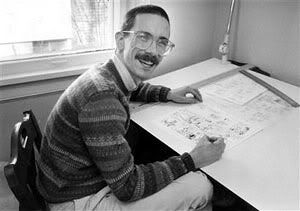
boy and they would say something that seemed funny, so they would keep reading the strip. Now think as that child matured into a teen and possibly even a college student, the meanings would go from the simple surface judgments to fully developed in depth thinking. The young adult would start to ask questions and be truly persuaded by the writing. Much of this is due in part to the medium used of cartoon writing. As Americans generally go,
Sunday Morning Cartoons are as part of our culture as 60s muscle cars and chasing the ice cream truck down the street. That means people respect cartoon writing as more than just a piece of entertainment, but a near priority. If someone puts something like comic reading so high, they must also have the sense to respect what it is saying, and after a time, the points will actually start being driven into their mindset. This is why Watterson stuck with cartoon writing as his means for persuading his points.
Going back to the cartoon, conventions are a main aspect of why it comes together so well, mostly because the cartoon doesn't stray far from normal cartoon format. There are some key points, for instance, the second panel is obviously where all the action of the cartoon happens, and that should be able to be seen without even reading the text. Watterson uses techniques such as zooming in on Calvin in particular, leaving out a frame and thought bubble in the second panel and also just the simple large amount of text that show this spot as the most obvious source of action in the cartoon. The second panel also yields a bit of political symbolism involving Calvin's trick or treating bag. Substitute Calvin for any general American. Now realize that he is telling this generous person that his costume is simply that of a "resource consuming kid," yet still holding out his bag for more. Surely, anyone could make the connection between Calvin in this strip and the United States as a whole. We know we consume, pollute and dispose of the most, yet we always seem to be reaching out and grabbing for more. Just look at the way we rely on other countries for our oil instead of producing our own. Likewise, the conventional change of covering the face of the person

handing out the candy shows that the person giving out the candy or "exporting " to the United States, can be anybody, but by covering the face, Watterson does not have to make an absolute ethnicity choice of the person, or even the gender. By making these only somewhat hazy connection, Watterson again puts his point across without stepping over the lines of the cartoon becoming an all out editorial persuasive political cartoon.
Even with all that in the second panel, the third is nearly as interesting. Though the simple, small amount of words and the very minute amount of drawing may detour most from capturing the full extent of the frame, it certainly has a lot to say. Again with the symbolism, after Calvin gets his "resources," before even getting away from the house, begins consuming what he has been given. Doesn't that sound strangely reminiscent of most industry in America? How about the entire idea of fast food? People go to a fast food drive through and begin eating during the ensuing drive to wherever they are going without even thinking about what they are doing. How many times have we seen or can we remember getting a toy when we were young and
needing to play with it as soon as possible before even getting back home? Often times, we were bored with the toy after a week anyway and it went unused. Similarly, Calvin appears to have munched all his candy away as quickly as it was given to him.
Calvin's adventure on Halloween is much more than a mildly humorous attempt at generating a costume out of being too lazy to make one. It truly gives a deeper symbolic look into how Americans generally feel and react to what they receive. Watterson's cynically political outlook on a simple childhood tradition is both comical, but a horrible realization at the same time. True, Calvin's intelligence did get him the candy he wanted, but it also perpetuated the poor cycle of
immediate gratification. Using a cartoon as such a medium to get this point across was an excellent idea and Watterson should be commended for such a strong ideas and means of getting his ideas out to a general audience.
Works Cited
"Comic Creater: Bill Watterson". Lambiek. 11-6-09 . "GoComics". UCLICK. 11-5-09 .
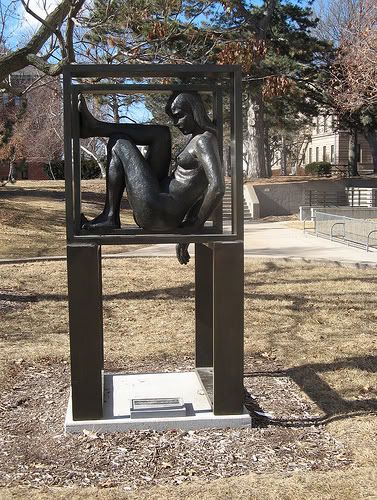 Truthfully, I was dismayed at first to be stuck with Richard Miller's "SANDY: in Defined Space," but after staring at it for the better part of an hour and a half, most anyone can develop some interest in a piece. In short, the sculpture is of a, most likely, younger twenties woman sitting naked inside one of several square shapes balancing on each other so that they in turn form a square shape when viewed from above. Though the bronze sculpture is not entirely intricate, nor does it seem to have been very difficult to construct for a skilled caster, but it does seem to have somewhat deeper meaning than simply an unclothed woman sitting in a box.
Truthfully, I was dismayed at first to be stuck with Richard Miller's "SANDY: in Defined Space," but after staring at it for the better part of an hour and a half, most anyone can develop some interest in a piece. In short, the sculpture is of a, most likely, younger twenties woman sitting naked inside one of several square shapes balancing on each other so that they in turn form a square shape when viewed from above. Though the bronze sculpture is not entirely intricate, nor does it seem to have been very difficult to construct for a skilled caster, but it does seem to have somewhat deeper meaning than simply an unclothed woman sitting in a box.